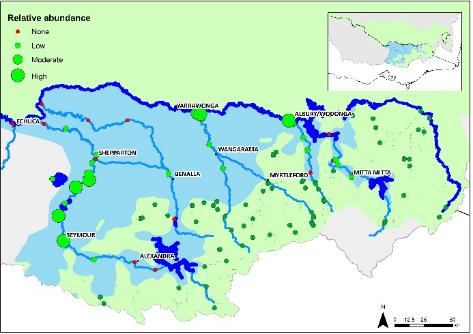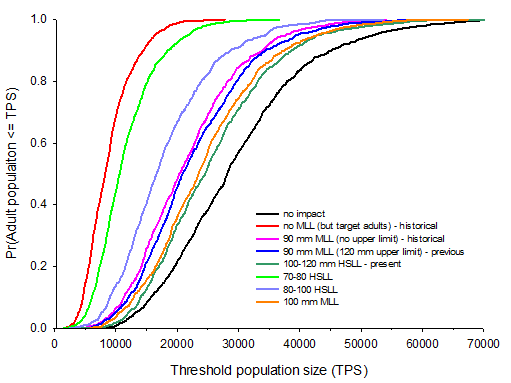The status of the Murray crayfish recreational fishery in Victoria
Executive summary
Murray crayfish is an iconic freshwater crayfish that forms an important recreational fishery across Victorian waterways. In addition to providing a valuable food resource, the Murray crayfish recreational fishery contributes socially and economically to local communities during winter months. Yet, this once widespread species has experienced substantial declines across its range, and is now classified as threatened within each state and territory that it occurs. Indeed, some areas of its range continue to experience a declining trend in population status. To ensure the benefits provided by the recreational fishery are maintained in the future, sustainable populations of the species are necessary, especially given the life‐history of this slow growing and late sexually maturing species. Whilst a range of conservation actions, such as flow and habitat management, will be necessary, it is acknowledged that sound management of the recreational fishery is critical to ensure long‐term population sustainability.
The Victorian recreational fishery has a long history of regulation, with the most recent amendments, informed by research and monitoring of New South Wales populations, occurring in 2013. These amendments implemented a harvestable slot length limit (HSLL = 100–120 mm occipital carapace length, OCL) and increased the duration of the closed season (September to May), whereas daily (two) and possession (four) limits were reduced (noting that protection of berried females was maintained). Whilst it was pragmatic to adopt consistent regulations (for the first time) across both Victorian and NSW recreational fisheries, the effectiveness of their impact on the status and sustainability of Victorian Murray crayfish populations remained unclear. This project helps to answer this key question through population benchmarking and exploration of long‐term trends at key sites (Section 3) and population modelling to evaluate a range of fishery management scenarios (Section 4). This multifaceted assessment provides the information necessary to inform sound management of the recreational fishery.
The benchmarking assessed key population parameters (abundance, length structure, sex ratio) across the spatial extent of the Victorian population. This was achieved through standardised sampling of lowland areas, which are target by recreational fishers (that is, accessible by boat), as well as compiling sampling data (courtesy of Arthur Rylah Institute) from upland areas to provide a more complete picture of the status of the species. A total of 469 Murray crayfish were recorded from the 43 lowland sites sampled, with distribution patchy (i.e. not detected at 15 sites) and abundance variable (0−0.38 crayfish net-1 hour-1).

The sampled Murray crayfish population, exhibited a broad and normally distributed length structure (19−156 mm occipital carapace length, OCL), with corresponding ages ranging between 0.9 to 19.3 years but most of the population was estimated to be less than eight years old (applying previously developed length‐at‐age relationships). The overall sex ratio was significantly skewed toward females (0.58 : 1, males to females), with a more pronounced female‐bias with the present HSLL range (0.28 : 1) although was almost in unity (0.8 : 1) for individuals below the HSLL. The size at onset of sexual maturity of 50% of females (SOM50) was estimated at 87.28 mm, whereas 95% of females (SOM
95) were mature at 104.44 mm.
This benchmarking only identified moderate to high relative abundance of the species in three areas – the mid‐Goulburn River (from Seymour to upstream of Shepparton), the lower Ovens River (downstream of Wangaratta to Murray junction) and Wodonga Creek. This reconfirms these areas as supporting stronghold populations, where greatest intensity of recreational fishing effort is anticipated. However, comparison of long‐term monitoring at key sites in these stronghold areas indicate that abundance has declined over the past 25 years, emphasising that conservative management is required. Across other sections of the Goulburn (downstream of Shepparton and upstream of Seymour) and Ovens (upstream of Wangaratta) catchments as well as the Broken, Kiewa and Mitta Mitta catchments (but not Campaspe, although small populations may persist in the catchment), the species persists in low abundance (<0.043 crayfish net-1 hour-1) or was not detected at over half of sampled sites. The species was broadly distributed across uplands areas, with 792 crayfish detected from 130 sites, yet almost all individuals observed were smaller than 84 mm, reflecting colder water temperatures and smaller waterways, and therefore do not form part of the recreational fishery.
A recently developed stochastic length‐based age structure population model was utilised to explore the influence of a range of length limit regulation scenarios on population sustainability (population risk, sex ratio, spawning potential) and harvest potential (mean number of individuals potentially harvested). Specifically, these scenarios related to historical (no length limit; 80 and 90 mm MLL), previous (90 mm MLL, with 120 mm upper limit to reflect the allowance to take one crayfish above this limit) and present fishery regulations (100−120 mm HSLL), as well as a number of alternative regulations (70−90 mm HSLL; 80−100 mm HSLL; 100 mm MLL). The modelling simulations undoubtedly emphasise that the present HSLL are most sympathetic to the species, affording the greatest population sustainability (i.e. lowest population risk, least skewed sex ratio and highest spawning potential) whilst achieving the highest harvest potential (i.e. number of individuals potentially harvested). In contrast, the historical as well as alternative scenarios investigated were deemed to be largely unsustainable with high population risk, skewed sex ratios and a

considerable reduction in spawning potential, thus resulting in the lowest harvest potential (due to smaller population sizes). Whilst the previous regulations (e.g. 90 mm MLL; with or without 120 mm upper limit) were an improvement on these historical regulations, they still resulted in inferior population sustainability and harvest potential compared to the present HSLL.
This investigation is the most comprehensive assessment of the Victorian Murray crayfish recreational fishery ever conducted. The assessment indicates that Murray crayfish occur patchily across Victoria, with the recreational fishery likely to be largely restricted to three stronghold areas, which have undergone declines in abundance over the past 25 years. Given this status assessment and the outcomes of modelling simulations, the main recommendation which can be put forward is retaining the present HSLL. It is acknowledged that whilst these present regulations manage fishing effort, they do not regulate overall harvest imposed by the recreational fishery; it is recommended to assess overall harvest through collaboration with recreational fishers, and it may ultimately be necessary to explore the suitability of a quota system (i.e. regulating overall harvest) for the species. It is also acknowledged that the potential closure of areas (e.g. such as lower Goulburn River) and reintroductions where low abundances and environmental disturbances persist may be warranted. Retaining the present HSLL would continue the consistency of regulation across both Victorian and NSW recreational fisheries, and supports moving toward a coordinated management approach across the whole range of the species. Implementation of a long‐term monitoring strategy, working with recreational fishers (to determine overall fishing effort) as well as addressing research priorities (including understanding movement patterns, population sizes and age structures) will be critical to the ongoing sustainability of the Victorian Murray crayfish recreational fishery.
Further information
For a copy of the full report please email richard.rogala@vfa.vic.gov.au
